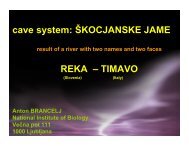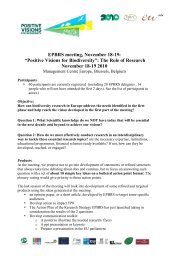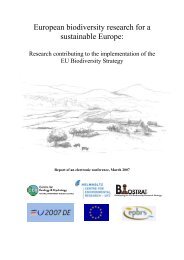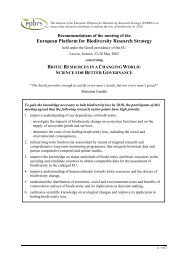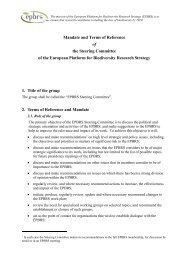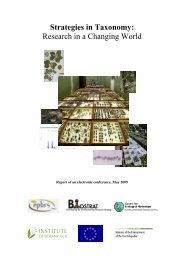Evaluation of the effectiveness of the New Instruments of ... - CORDIS
Evaluation of the effectiveness of the New Instruments of ... - CORDIS
Evaluation of the effectiveness of the New Instruments of ... - CORDIS
You also want an ePaper? Increase the reach of your titles
YUMPU automatically turns print PDFs into web optimized ePapers that Google loves.
6. Comparison with FP5 and traditional instruments<br />
Opinions are clearly in favour <strong>of</strong> a continuation <strong>of</strong> <strong>the</strong> co-existence, with a significant group<br />
that would prefer traditional instruments to be enhanced.<br />
A question was included to verify <strong>the</strong> previous experience <strong>of</strong> respondents with EU RTD.<br />
The results are given in <strong>the</strong> table below.<br />
No Once More than Never<br />
reply<br />
once<br />
Have been coordinator <strong>of</strong> a project funded by EC 10% 22% 32% 36%<br />
RTD in <strong>the</strong> past<br />
Have been a participant 11% 10% 59% 20%<br />
Have applied unsuccessfully 20% 15% 38% 27%<br />
The Experience level <strong>of</strong> successful participants is significantly higher as from unsuccessful<br />
applicants. This result is not surprising.<br />
Of <strong>the</strong> 145 unsuccessful applicants, 31 have answered ‘never’ on all three questions above.<br />
For <strong>the</strong> 115 successful applicants, this figure is 14 only.<br />
Table 6.1: Comparison <strong>of</strong> an IP / NoE as an instrument with a traditional shared cost<br />
research project in previous FPs (n=230, those who have previous experience with<br />
EU RTD) (on 5-points scale, whereby 5 = much higher / better with new instruments<br />
than with previous instruments)<br />
Statement<br />
Successful<br />
n=116<br />
Unsuccessful<br />
n=114<br />
The possibility to fit <strong>the</strong> needs <strong>of</strong> my organisation 3.1 2.6<br />
The share <strong>of</strong> time needed from <strong>the</strong> co-ordinator for<br />
4.0 3.8<br />
management issues<br />
The level <strong>of</strong> ambition 4.1 3.9<br />
The level <strong>of</strong> risk-taking (scientific and o<strong>the</strong>r risks) 3.6 3.3<br />
The level <strong>of</strong> flexibility allowed in <strong>the</strong> course <strong>of</strong> <strong>the</strong> project (in 3.8 3.5<br />
terms <strong>of</strong> size <strong>of</strong> <strong>the</strong> consortium and content <strong>of</strong> <strong>the</strong> project)<br />
The level <strong>of</strong> bureaucracy 3.3 3.5<br />
The level <strong>of</strong> complexity <strong>of</strong> IPR issues 3.7 3.8<br />
The level <strong>of</strong> cost-efficiency for <strong>the</strong> project co-ordinator 3.0 2.9<br />
The chart below gives <strong>the</strong> average result regarding <strong>the</strong> co-existence <strong>of</strong> new instruments<br />
with traditional instruments. There are significant differences between <strong>the</strong> successful and<br />
unsuccessful applicants. Those considering traditional instruments should be enhanced<br />
represent 28 % <strong>of</strong> <strong>the</strong> successful applicants, and 47 % <strong>of</strong> <strong>the</strong> unsuccessful.<br />
67



